Atlas Points
By Chistopher Hoeting
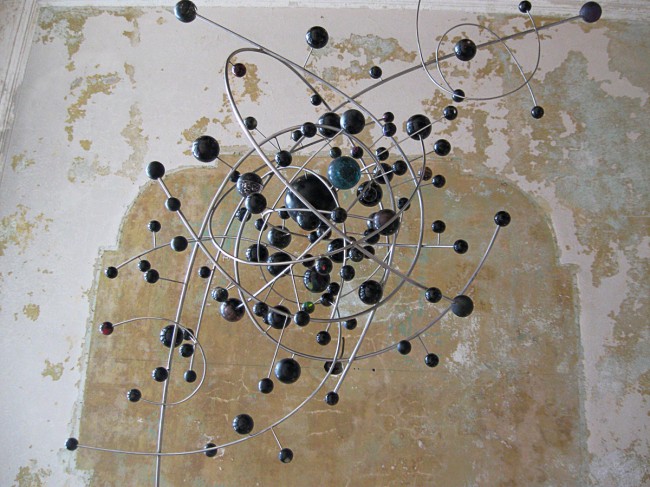
Cincinnati’s Emery once again opened its doors for the third consecutive year (under the leadership of The Requiem Project) with two shows this past weekend: Atlas Points—the visual arts component of Cincinnati’s MusicNow and FORTY/40—the Contemporary Dance Theatre’s 40th Anniversary celebration. These two significant events demonstrate The Requiem Project’s continued efforts at The Emery and indicate the company’s long-term commitment to theatre.
I began my relationship with The Requiem Project in 2011 as a collaborator, a featured artist, and a committed volunteer. As I currently serve as the theatre’s Art Director, I feel it is important to note that the diverse programming that our company has been able to accomplish in this formerly shuttered theatre over the course of a very short period of time is something which I am very honored to have been a part.
One important aspect of what was so striking about this weekend at The Emery was the representation of the distinct power of collaboration. This past weekend at the theatre signifies valuable partnerships between hyper-local and fixed organizations such as the Contemporary Dance Theatre, Memorial Hall, and The Emery and fluid artists with important ties to our city (artists born here in Cincinnati) who travel back and forth from Brooklyn (and elsewhere on the globe) to offer artistic experiences (who invite the greater global community) to our city for high-level cultural exchange.
Atlas Points was the dedicated visual arts exhibit for MusicNOW, an eight-year-old, widely embraced music festival curated by founder and Artistic Director Bryce Dessner (Dessner is a Cincinnati native and is internationally-known as a founding member of the acclaimed band The National). Atlas Points featured two Cincinnati raised and New York based artists— Jessie Henson and Nathlie Provosty.
Dessner states, “I first met native Cincinnatians Jessie Henson and Nathlie Provosty in Brooklyn—both women are not only accomplished artists living and making work in New York City, but they were also raised in Over-the Rhine and Northside here in Cincinnati. Since founding MusicNOW in 2006, I have sought ways to bring visual art into the festival. Over the years we have commissioned several on-stage installations for Memorial Hall, including the light boxes from Karl Jensen that continue to adorn the stage every year. Atlas Points is the most ambitious visual collaboration we have done to date and it is a great honor to present Nathlie’s and Jessie´s work in their hometown and in the majestic Emery. Nathlie’s and Jessie´s work is deeply engrossing; it transports in the same ways that I have sought to accomplish in the musicians we present every year at the festival.”
The intimate MusicNOW exhibition was in the unadorned corridors and reception parlors at the theatre that The Requiem Project uses as gallery spaces for rotating exhibitions. Previous exhibitions within these spaces have included artists such as Michael Wilson, David Sheldon, Mike Disfarmer, and Cedric Cox. Atlas Points was presented on the curved wall (the corridor behind the mezzanine section of the theatre). The exhibit commenced with a series of paper works by Jessie Henson (ten flat pieces) entitled Untitled (after drawing on clouds)—a series of atmospheric ink-wash drawings with sequins and nails creating a variety of galaxy/cloud like patterns on the surfaces—and was joined by a whimsical mobile of a suspended stainless steel framework in a spiraling gesture of orange and red analogous-colored, spherical shapes by Jessie Henson entitled Exploding. Henson remarks, “These works focus on the tiny, abandoned, or neglected things of childhood—marbles and bouncy balls—and freezes them in mid-throw.”
Immediately through the threshold and into The Emery’s parlor room-opposite of the ink drawings-was Henson’s largest work and most impactful in the exhibition entitled, Time Before, Time After. The piece has a larger linear framework of a descending stainless steel structure where, at the end of every steel line, sits a dark-colored sphere. The piece is made up of dozens of moving balls with a larger variety of different sized spherical shapes that play on the weighting within the composition. This artwork is less whimsical than the more colorful arrangement in the hallway but it is more effective due to the complexity of line and movement created within the composition.
Henson’s description fits nicely with Time Before, Time After. She states, “With this work, I am creating a series of personal skies for my viewers, viewers who interact with the “stars” in a very intimate way. These intricately crafted maps of the galaxy offer a commentary on the place of one person’s life in a community and the connections between the individual and society. They invite viewers to reflect on their specific place in a larger universe. The works further explore the tension between the concrete reality of ordinary life and the search for escape through fantasy and whimsy, making visible an interior world of play and personal narrative.”
With Time Before, Time After, I am left reflecting on…NOW. This fills me with an overwhelming sense of melancholy; it only seams appropriate given the context of the current exhibition.
Flanking Henson’s large mobile in the parlor sits a perfectly symmetrical presentation of three paintings by Nathlie Provosty. Provosty’s works on canvas echo the spherical shapes that Henson introduces earlier in the exhibition, yet her work goes a step further by reducing the ingredients (and overall movement) to focus on more subdued variation on the painted surface. I personally feel that the conversation between the room’s peeling green paint and white plaster create an enormous conversation with the mainly reduced color palettes.
Nathlie Provosty’s largest piece included in the exhibition is comprised of two large canvases (paintings) named Valence Violence Violets. Provosty reveals that this piece “derives its armature from the arced calendar of the Limbourg brothers’ “Très Riches Heures du Duc de Berry” (1412-1416). As the presence of this famous allegory of time might suggest, much of my work deals with temporality, symbolically and phenomenally—searching for ways to enact both the collapse and passage of time within the experience of the visual field.”
This work was presented on bricks and the work leaned gently inward on the largest curved wall in the room—one canvas sloping toward the other. Valence Violence Violets is the largest piece within the exhibition and is divided between two panels that are largely symmetrical. There are two circles on the left composition that are stacked together with opposing blue lines stretched upward on the top circle and downward on the bottom circle—like a dial or clock. On the left composition, the two circles are echoed in the same configuration, yet contrast panel number one – the dials are facing downward on the top circle and stretch horizontally on the bottom circle.
The painterly surfaces are mainly comprised of monochromatic neutral colors. The larger background was built with soft blended paint strokes and was created with a matte finished surface, while the circular shapes that dominate attention are darker and colder in temperature; they are much more reflective in nature. The blue, “dial like” linear elements dominated the movement of the design but I particularly liked the outer edges of the painting that folded inward to create a collapsing effect.
On the opposite wall Provosty’s two smaller works entitled Beacon and Bound Bounds split the threshold in the parlor room. Of the two, Beacon is a much more gestural piece and continues to play on the repeating circular motif on a soft yellow backdrop. This movement was created by active paint handling with dark black and umber blends. The fresh paint handling reminds me of the smaller portrait pieces of Marlene Dumas.
To the right of the threshold is the piece entitled Bound Bounds. This work has a similar subdued monochromatic neutral palette as Valence Violence Violets, but it is in a colder temperature color family. The central shape is comprised of a large light blue top-heavy hourglass shape that is built by adjacent dark shapes converging on the center like a torso.
Overlapping both the darker and lighter sections of the painting is three brightly colored small circles left of center. What is most interesting about this piece is the construction of the paint handling in relationship to the shifting space and the edge treatment. This piece demands the most attention in the show and lies across the textured surface like it was meant to grace its walls. Provosty speaks of referencing Aby Warburg’s Mnemosyne Atlas and (in her atlas paintings) the attempt to combine the philosophical with the image-historical approach is effectively interwoven into the paintings and loudly heard in the halls of The Emery.
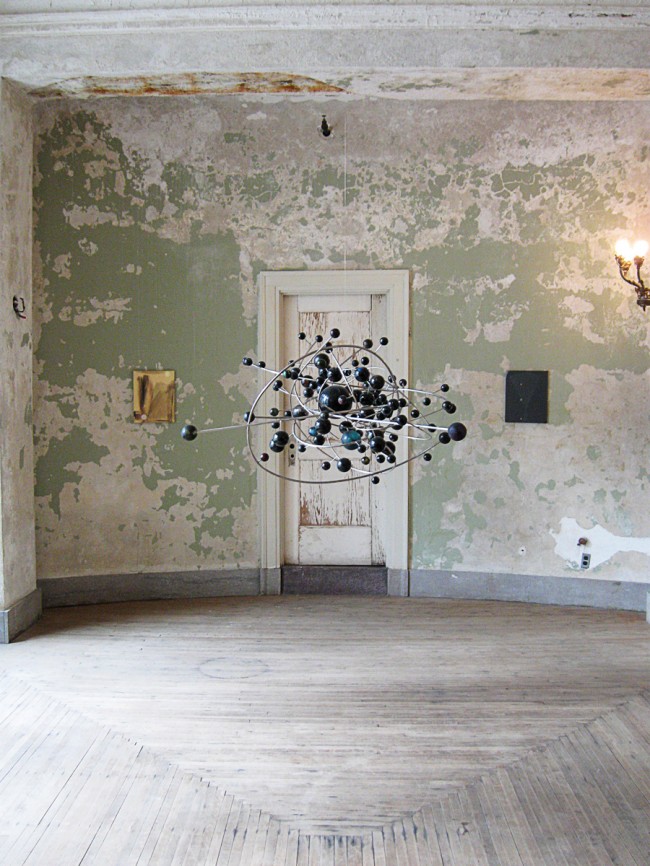
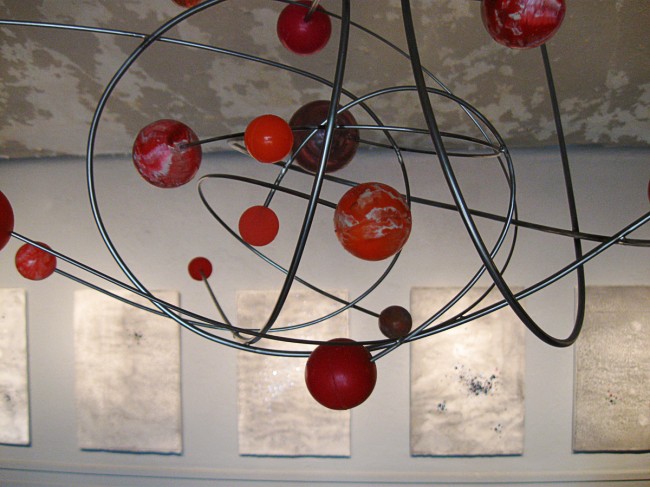
Sustaining the Future, Analyzing the Present, and Looking into the Past.
If you are looking to understand what the future of the Emery looks like and how it is very different as a unique cultural institution, you ought to walk right through the front door and discover the finger prints left by the managing entity of The Emery, A Requiem Project. What you will discover in this Emery is a theatre that was reborn with the distinct intention to fulfill what philanthropist (and visionary) Mary Emery put forth for our city over 100+ years ago. The company was developed to honor the theatre’s rich musical history, to rediscover the lost history of inclusion that the space represents, and to understand its multidisciplinary possibility as an art center.
I can think of no better way to introduce this vision than to have taken a tour through the front door and to look to the echoes of programming throughout the first and second floors of the theatre. Upon entering the room displaying traditional beauty of the cream colored marble lobby, it is clear from the onset that the company is mixing innovative and historic and leaving a clearing for creative possibility.
Looking to the right in the Lobby, where the old box office once was, is sound installation by Paul Schuette entitled Circuit Drawing #2. This installation is one of four sound sculptures Schuette installed throughout the theatre last fall to complement his Doctoral Thesis Recital/Performance (University of Cincinnati’s CCM) on The Emery Stage. Circuit Drawing #2, what looks to be speaker wires wrapped around brass, is an intentional sound arrangement that is activated by the magnetic stripe of a credit card (magnetic stripes play a wholly specific compositional element).
On the left side of the lobby is a cast bronze and wood piece by Margo Gotoff, entitled Requiem, loaned to The Emery in April of 2012. Gotoff’s first exhibit at The Emery was in the Fall of 2011, when the former “coat check” room was made into a gallery space that exhibited Gotoff’s classically-inspired glass figures and a series of casts and molds that represented the arduous process of creating these graceful pieces.
Entering just through the lobby into the curved corridor is a large photograph by artist Darrin Ballman. In this photograph, you can see a fully-lit exterior of The Emery building during the “11.11.11” opening of The Emery under The Requiem Project, their inaugural and signature event that previewed the theatre with “art everywhere.” The centerpiece of the lobby is the large reconditioned original marquee sign made into a light box by craftsman and artisan Mark Krotchin, illuminating the letters E-M-E-R-Y on its side horizontally. Flanked by the sign and clearly stated on white panels is The Requiem Project’s Mission and Vision statements; just below are two white empty chairs with an antique table (with lace fabric housing flowers and a Contemporary Dance Theatre Company’s program from a performance at The Emery some decades ago). I like to think of this arrangement and attention to care put into the theatre as just a part of Co-founders and Co-Directors Tara Lindsey Gordon’s and Tina Manchise’s touches and attention to detail throughout the theatre. Every spot has their fingerprints.
Entering the main auditorium and wrapping around (both) the left and right sides of the space are a series of Darrin Ballman photographic prints that document the “11.11.11” benefit. The subjects of the photography include images of partners and collaborators: Exhale Dance Company, The Cincinnati Ballet, the band Over-the-Rhine, concert:nova, Cincinnati Symphony, and the art installation by photographer Michael Wilson. Overhead on the large projection screen is a video piece called Exit Strategy, by Brandon Morse, who exhibited with The Requiem Project in the first-off site program from The Emery as part of Fotofocus, The Gateway Art Festival. This piece is a code-generated image of a morphing and collapsing cityscape. Just to the left and right of stage in the archways are two pieces, on loan from Susan Byrnes, History is a long braid suspended from a silver mirror, Silver Linings is a series of paper casts of women’s lingerie. These pieces were introduced to The Emery during the regional premier of the film Derby Baby! at The Emery in July 2012 and was selected to complement the film. Byrnes had a solo show in conjunction with the film premiere and developed a free educational program at The Emery, consisting of creating instruments from found objects; that program was called “Mending is Better than Ending.”
Under the stairs on the first floor are large color posters from the Contemporary Dance Theatre’s history. The Contemporary Dance Theatre Company once again graced the stage of The Emery this past weekend. This important event featured a celebration of the 40 years of the organization, most notably the career of founder and artistic director Jefferson James, who developed an organization that brought modern dance to the city of Cincinnati some four decades ago. Although the event had no formal performances it did re-introduce the new members of the organization to The Emery, which CDT once formally called home.
Central to the table is both a collection of recent artifacts and historic archives from the theatre. On the corner of this table is small flat panel playing the recording sessions shot and curated by Michael Wilson, which may be one of the greatest assets to the theatre as a messaging tool and highlights the great donation by the many artists who gave their music to this revival effort, including Grammy award winning artist Bill Frisell, Over-the-Rhine, and Buddy Miller & Jim Lauderdale. To the left of this table and into the next room is a corridor with John Senhauser Architects and Westlake, Reed and Leskowski’s renderings for the future of The Emery post renovation, which include a roof-deck garden, a second stage, and restaurant space.
Throughout the MusicNOW opening, visitor constantly remarked that the theatre is like something that you might see in New York, which is exactly what the Co-founders intention was when founding the non-for-profit arts organization. Looking to venues like Brooklyn Academy of Music (BAM) and The Boston Center for The Arts (BCA) for inspiration to create an eclectic venue that has depth in programming and an open door for philanthropic partnerships with organizations such as Starfire U and The Homeless Coalition.

Fact Sheet:
The Requiem Project is a not-for-profit arts company with the mission to revive the historic venue as an arts center that offers opportunities for collaborations, and arts-based educational opportunities through dance, music, theatre, film and the visual arts. In 2008, the organization began a straightforward path to re-establish the formerly shuttered Emery as an interdisciplinary arts center in the heart of Over-the-Rhine.
The Requiem Project re-opened The Emery for the theatre’s centennial year (2011-2012) to articulate the aesthetic vision of the company, to partner with other arts organizations, and to gauge the public’s response to the operation of the once moribund theatre. Over 35 events were produced in the inaugural year. 10,000 peopleattended concerts, theatre and dance shows, visual arts exhibits, and community events.
Programs included presentations and collaborations with the band Over The Rhine, Daniel Martin Moore, Ric Hordinski, Joan Shelley, Starfire U., The Fringe Festival, SCPA, Exhale Dance Tribe, Midpoint Music Festival, Bill Frisell and The 858 Quartet, concert:nova, the Contemporary Dance Theatre, Prairie Gallery, FOTOFOCUS, The Gateway Arts Festival featuring Ilkka Halso, a Disfarmer photography exhibit, Dean Wareham and Britta Phillips, the Contemporary Arts Center, and a series of music videos—The Emery Sessions—curated by Michael Wilson.
The Emery, one of three acoustically pure theatres still standing in the nation, is a sister building to Carnegie Hall. Bequeathed to the city of Cincinnati by philanthropist Mary Emery in 1908, The Emery’s stage has been shared with Leopold Stokowski, the Cincinnati Symphony, Vaclav Nijinsky, Ann Pavlova, George Gershwin, Eleanor Roosevelt, Martin Luther King, Jr., Martha Graham, and Merce Cunningham, among other significant artists and activists who have influenced arts and culture over the past one-hundred years. The Emery has hosted events from the Federal Theatre Project, to NAACP conferences, to radio shows, to silent films and the theatre was once even the home to the American Theatre Organ Society and the Mighty Wurlitzer Organ.
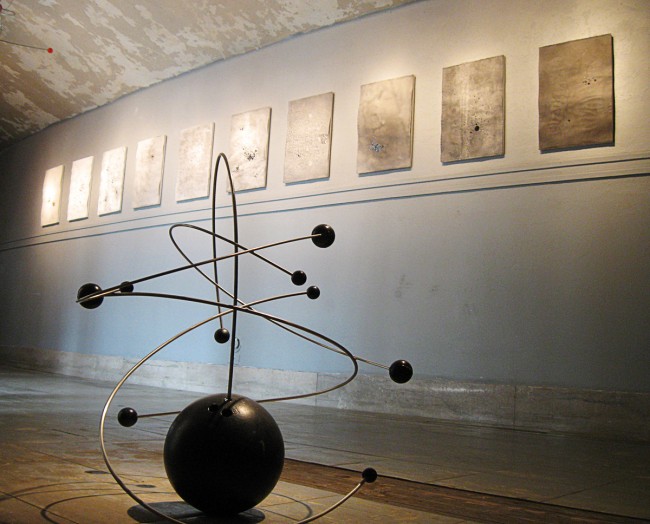
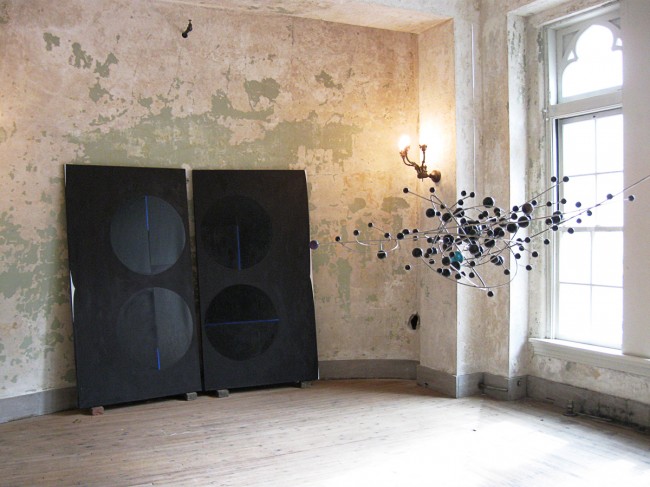
Chris, Wow!! this is a beautiful and divine piece, weaving so many threads of past and present artistic components together, and all I can say is . . . that it seems that The Emery has EVERYTHING going for it!! So, I hope and pray that the stalled train gets BACK ON TRACK, and moving at a delightful pace for all to enjoy and celebrate . . . AND SOON!! PLEASE!! and so Chris, what can i do to help? deb
Chris, Wow!! this is a beautiful and divine piece, weaving so many threads of past and present artistic components together, and all I can say is . . . that it seems that The Emery has EVERYTHING going for it!! So, I hope and pray that the stalled train gets BACK ON TRACK, and moving at a delightful pace for all to enjoy and celebrate . . . AND SOON!! PLEASE!! and so Chris, what can i do to help? deb
and! I should clarify, that it is currently “on track,” moving at a good pace, yes, but The Emery needs to be moving FULL SPEED AHEAD!!! IT REALLY DOES HAVE EVERYTHING GOING FOR IT!!
and! I should clarify, that it is currently “on track,” moving at a good pace, yes, but The Emery needs to be moving FULL SPEED AHEAD!!! IT REALLY DOES HAVE EVERYTHING GOING FOR IT!!
First off the series of works on paper were not done by Nathlie Provosty, but rather Jessie Henson.
The work exhibited by both artists in the show had a similar use of geometric motif, in the paintings it shows itself in the use of the circles as an organizing principle. In the sculptures the form of the sphere is repeated. I found the dialogue between the works interesting inthis way.
With the large dark paintings by Provosty I noticed how the reflection and absorption of light in the circles altered my perception of what colors I was seeing. As I walked from the far left side to the right the afternoon sun coming through the bay window transformed the circular surfaces from a rich turquoise to a glassy black. When I stood dead center and focused on the bright blue strips my eyes created the optical illusion of orange on the sides of my vision. I was told there was no black paint used in the paintings. For me the paintings were a kind of meditation on color, illusion, and light.
First off the series of works on paper were not done by Nathlie Provosty, but rather Jessie Henson.
The work exhibited by both artists in the show had a similar use of geometric motif, in the paintings it shows itself in the use of the circles as an organizing principle. In the sculptures the form of the sphere is repeated. I found the dialogue between the works interesting inthis way.
With the large dark paintings by Provosty I noticed how the reflection and absorption of light in the circles altered my perception of what colors I was seeing. As I walked from the far left side to the right the afternoon sun coming through the bay window transformed the circular surfaces from a rich turquoise to a glassy black. When I stood dead center and focused on the bright blue strips my eyes created the optical illusion of orange on the sides of my vision. I was told there was no black paint used in the paintings. For me the paintings were a kind of meditation on color, illusion, and light.